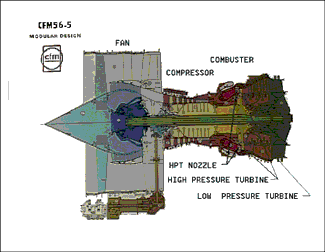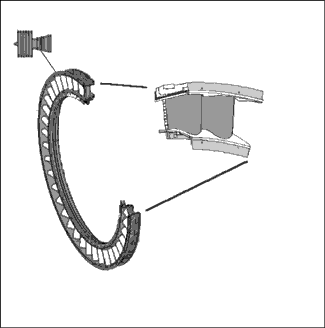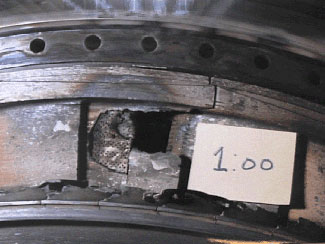Engine failure
Air Canada Airbus A320-211 C-FFWJ
Montreal International (Dorval) Airport,
Quebec 45 nm W
The Transportation Safety Board of Canada (TSB) investigated this occurrence for the purpose of advancing transportation safety. It is not the function of the Board to assign fault or determine civil or criminal liability. This report is not created for use in the context of legal, disciplinary or other proceedings. See Ownership and use of content. Masculine pronouns and position titles may be used to signify all genders to comply with the Canadian Transportation Accident Investigation and Safety Board Act (S.C. 1989, c. 3).
Summary
An Airbus A320 aircraft, Air Canada flight 431, was on a scheduled domestic flight from Montreal International (Dorval) Airport, Quebec, to Toronto/Lester B. Pearson International Airport, Ontario. The take-off and departure were normal until a loud bang was heard while the aircraft was climbing through flight level 280. The flight crew immediately observed the rpm of the No. 2 engine (CFM International [CFMI] CFM56-5A, ESN 731-308) decrease as the exhaust gas temperature (EGT) increased. The engine was shut down. After securing the engine, the flight crew notified company maintenance and carried out an uneventful single-engine landing at Toronto with emergency response services standing by.
Factual information
The failed engine was removed from the aircraft and shipped to the Air Canada engine teardown facility in Montreal where it was dismantled and inspected. The inspection revealed extensive internal damage to the high pressure turbine nozzle assembly (HPTN) and the high pressure turbine (HPT) sections, extending back to the low pressure turbine (LPT) sections. The nature and extent of the damage was consistent with an initial failure in the HPTN and HPT sections.
The engine HPTN is a single-stage, air-cooled assembly which directs the gas flow from the combustion chamber to the HPT rotor blades. The assembly is made up of 21 nozzle segments, and each segment has two guide vanes. High pressure compressor discharge air, used for cooling, enters each vane through the nozzle segment inner and outer platforms and exits through holes in the leading and trailing edges of the guide vanes.
The engine manufacturer's part numbers for the nozzle segments in the failed engine were 1668M37G02 and 1668M37G03.
The Serviceable/Maintenance Release tags for the HPTN segments noted that the parts had been "PACH [Partitioned Alloy Component Healing] repaired" for service evaluation. Impact damage, blue heat discolouration, trailing edge cracking, and trailing edge corner breakout were noted across the trailing edges of all of the HPTN guide vanes. Cracks in the convex side and material distress were also noted on five nozzle guide vanes. One of the nozzle guide vanes had a large section missing from its aft panel (convex side adjacent to the HPT rotor), and an adjacent portion of the trailing edge of this vane had been burned and eroded away with the loss of cooling air.
Examination of the fractured surfaces of the missing section of the assembly nozzle guide vane indicated that the separation was progressive in nature and occurred during normal engine operation.
The failure of the material on the convex face of the guide vane was consistent with low-cycle fatigue related to thermal stress. When the panel was liberated, the loss of cooling air meant the trailing edge of the vane was now subjected to more heat than the material could withstand and it was subsequently burned and eroded away. Examination of both the construction material and the repair material showed that both were in compliance with the manufacturer's specifications.
The HPT rotor assembly is a single-stage turbine with 80 air-cooled, dove-tailed blades. The failed HPT rotor blades and HPTN assembly nozzle segments were sent to the TSB Engineering Branch for metallurgical examination. All 80 turbine airfoils separated within 0.3 inches of their respective platforms. The fracture surfaces on all but one of the separations were characteristic of overload separation. The fracture surface of the remaining blade had a flat planar crack which originated at or near the trailing edge of the blade and propagated forward toward the leading edge of the blade.
The engine manufacturer, CFMI, had experienced cracking problems on the convex face of HPTN guide vanes in the past. These cracks, if undetected, could propagate and eventually result in the loss of a section of the convex face of the nozzle guide vane. To ensure that the HPTN assemblies were removed from service before the nozzle guide vanes failed, CFMI developed a repetitive inspection process to detect defective HPTN guide vanes. The inspection criteria were detailed in CFMI service bulletin (SB) (CFM56-5) 72-170, which required a borescope inspection of the convex surface of the HPTN guide vanes to identify any cracking and/or material loss. A first inspection was to be performed after 3,200 cycles, and, depending on the nature of the cracks, re-inspections would be carried out after every 800, 400, or 100 cycles. Compliance with the SB was voluntary.
SB 72-170 was an interim control program which was brought into place while CFMI modified the nozzle design. The design improvements increased the nozzle durability and reduced its susceptibility to cracking of the convex face. The redesigned HPTN assemblies were re-identified as P/N 1358M73G30 and 1358M73G32. The installation of the redesigned HPTN assemblies as per CFMI SB (CFM56-5) 72-207 removed the need for the borescope inspection of the convex face of each guide vane as detailed in SB (CFM56-5) 72-170.
CFMI also developed a repair procedure to recondition unserviceable HPTN guide vanes which had cracked and been removed from service. Various size cracks, including thru-cracks had been brazed-fill repaired via Partitioned Alloy Component Healing (PACH). In addition to the repair, the nozzles were modified to meet the latest design and re-identified in SB (CFM56-5) 72-207 as P/N 1668M37G01, 1668M37G02, and 1668M37G03.
CFMI invited three airlines to participate in an "in-service" evaluation of five sets of repaired HPT nozzles. Contingent on Air Canada participating in the evaluation, CFMI, through its on-site representative, offered Air Canada two repaired HPTN assemblies at no charge. These were accepted and introduced into the Air Canada fleet. It was the view of Air Canada's maintenance and engineering staff that this offer was to compensate Air Canada for having to remove HPTNs prematurely because of cracks. The CFMI maintenance release tag stated in the comment section, "Parts have been PACH repaired for service evaluation." Air Canada's past experience with PACH type repair methods performed by the same vendor on CFM56-26 and Rolls Royce HPTN assemblies had been favourable. Neither Air Canada nor either of the engine manufacturers had in the past found it necessary to reduce the inspection interval on HPTN assemblies repaired by this method. Air Canada therefore had no hesitation in accepting these parts for the CFM56-5A engines.
In an internal CFMI document, the CFMI engineering department had requested that the service evaluation include an 800-cycle repetitive borescope inspection of the HPTN assembly, including the convex side of the nozzle guide vanes (as per SB [CFM56-5] 72-170), and that, if possible, a CFMI engineer be present when these inspections were carried out. CFMI's on-site representative at Air Canada rewrote the request and stated only that, "an inspection after 800 hours is requested", and there was no mention of either inspecting the convex face or CFMI's desire to be present for the inspection.
The Air Canada engineering staff decided that an 800-hour (400-cycle) inspection was not required and did not action the request. Since the part numbers of the new HPTN were identified in SB (CFM56-5) 72-207, which stated "Incorporation of this Service Bulletin eliminates the need for the special on-wing borescope inspection per Service Bulletin (CFM56-5) 72-170R1," Air Canada decided to inspect the repaired HPTNs every 1,600 cycles. This decision was made without consulting the manufacturer.
The CFMI engineer responsible for the service evaluation program sent correspondence to CFMI's on-site representative at Air Canada on two occasions. The purpose of the correspondence was to confirm that the airline had agreed to participate in the evaluation and would inspect the convex surface of the HPTN assembly nozzle guide vanes with a borescope every 800 cycles and document the inspection results. At this time, there was a change of CFMI personnel at Air Canada. The first correspondence arrived immediately prior to the departure of the first representative and the second arrived shortly after the arrival of the second representative. The significance of the request was missed in the hand-over of responsibilities, and there is no indication that the information was passed on to the Air Canada engineering staff. The repaired HPT nozzle guide vanes underwent two 1,600-cycle inspections at Air Canada. Air Canada's inspection did not include a borescope inspection of the convex side of the nozzle guide vanes, and no documentation regarding the inspections or the condition of the guide vanes was provided to CFMI.
Subsequent engineering evaluations and calculations by CFMI revealed that the missing trailing edge section of the nozzle guide vane would cause a disruption in the flow of air through the nozzle. The disrupted airflow would produce a regular pulse wave on each of the turbine blades as the blades rotated past the damaged (missing) nozzle guide vane area. The pulse induced by the disrupted airflow was not, in itself, considered significant enough to cause an HPT blade to fatigue and fail. However, it was considered that, if one of the blades had a stress concentration point, such as a trailing edge crack, the pulse would be of sufficient magnitude to cause the crack to progress to the point of ultimate failure.
Analysis
The engine suffered a catastrophic internal failure when one of the HPT blades failed under normal operating conditions. The HPT blade had a fatigue crack which propagated to a point where the weakened blade could not withstand the normal operating forces imposed on it, and the blade separated from the rotating HPT rotor assembly. The liberated blade air foil interfered with adjacent and downstream moving engine parts, resulting in the overload separation of the remaining HPT blades and secondary low pressure turbine impact and over temperature distress.
The fatigue crack found in the HPT blade originated at or near the blade trailing edge and progressed forward towards the leading edge of the blade. The originating defect in the trailing edge of the blade was not identified. However, the presence of a small defect in an engine HPT blade, although undesirable, is not uncommon. Developmental testing by CFMI has established a crack acceptance limit of 0.10 inch of crack length. Cracks of less than 0.10 inch have been shown by CFMI not to be a threat to blade integrity; therefore, there is no reduction of the inspection interval time for blades cracked within that limit. The Air Canada boroscope inspections did not detect any cracks which exceeded that limit of 0.10 inch. The missing segment of the HPTN assembly nozzle guide vane, while in itself not significant enough to cause a sound HPT blade to fail, was significant enough in combination with the slightly defective HPT blade to result in failure of the HTP blade and, ultimately, internal failure of the engine. The HTP blade failed in fatigue.
The failed engine HPTN assembly was a repaired unit, provided by CFMI for an in-service evaluation of the repair procedures. The evaluation criteria written by the CFMI engineering department included an 800-cycle repetitive inspection of the convex surface of the nozzle guide vanes to monitor the status of the repaired nozzle segments. It could not be demonstrated that this information was communicated directly to the Air Canada engineering and maintenance departments.
The inspection information that was received by the Air Canada engineering and maintenance department, after being passed through several CFMI departments then several Air Canada departments, was incorrect--it detailed that a one-time, 800-hour inspection was required, and made no reference to the borescope inspection criteria for the convex surfaces of the HPTN assembly nozzle guide vanes. In addition, since the part number on the repaired HPTN assembly was identified in SB (CFM56-5) 72-207, the Air Canada engineering and maintenance staff assumed (without consulting with CFMI) that a 1,600-cycle inspection which did not include a borescope inspection of the guide vane convex surfaces was adequate.
Consequently, the repaired HPTN assembly nozzle guide vanes were not being inspected in accordance with the CFMI engineering recommendations for the service evaluation, and the fact that the convex surface of a nozzle guide vane had a substantial amount of material missing went unnoticed until the engine failure.
The following Engineering Branch report was completed:
- LP 179/95 - Turbine Blade Failures.
Findings
- CFMI developed a repair scheme for cracked HPTN assembly guide vanes, supplied Air Canada with two repaired assemblies, and requested that Air Canada participate in an in-service evaluation program of the repaired componennts.
- The repetitive inspection criteria to be used during the in-service evaluation of the repaired HPTN assembly nozzle guide vanes were not accurately conveyed to Air Canada.
- Air Canada did not follow the inspection criteria they were given, nor did they query CFMI to ensure that the inspection cycle they employed was adequate.
- Since SB (CFM56-5) 72-207 did not specify an inspection interval for the redesigned nozzle segments, Air Canada interpreted that the 1,600-cycle inspection procedures were adequate for the HPTN assembly components provided for the in-service evaluation.
- The undetected progressive deterioration of an engine HPT nozzle segment guide vane contributed to the propagation of a fatigue crack in one of the engine's high pressure turbine blade air foils.
- The HPT blade failed in fatigue during normal engine operation, and the liberated blade caused the internal failure of the aircraft engine.
Causes and contributing factors
A high pressure turbine blade failed in fatigue during normal operation of the aircraft engine, causing catastrophic internal failure of the engine. Contributing to the blade failure was undetected damage to a repaired engine high pressure turbine nozzle assembly. Inspection requirements were not accurately communicated to Air Canada by the engine manufacturer, nor did Air Canada follow the inspection requirements they were given.
This report concludes the Transportation Safety Board's investigation into this occurrence. Consequently, the Board, consisting of Chairperson Benoît Bouchard, and members Maurice Harquail, Charles Simpson and W.A. Tadros, authorized the release of this report on .


